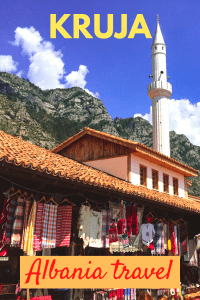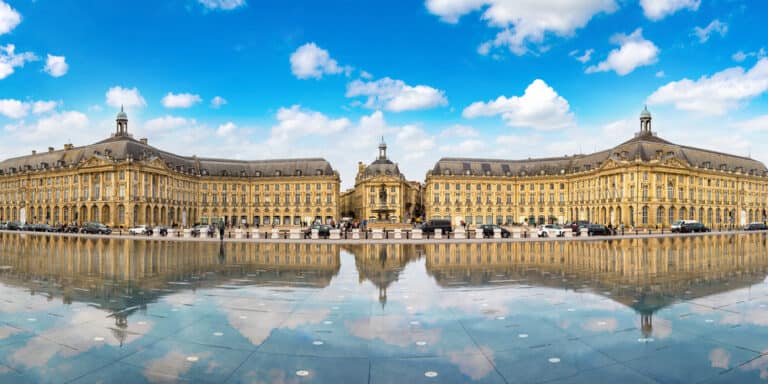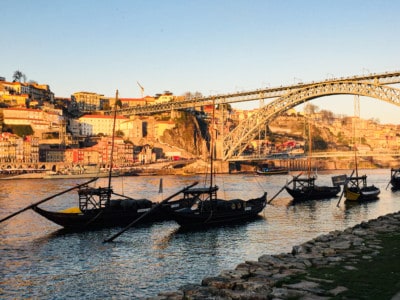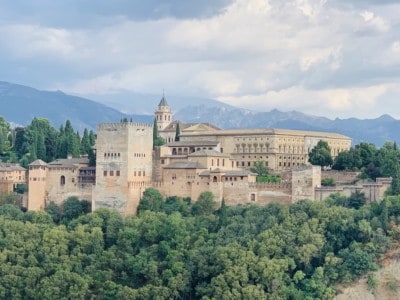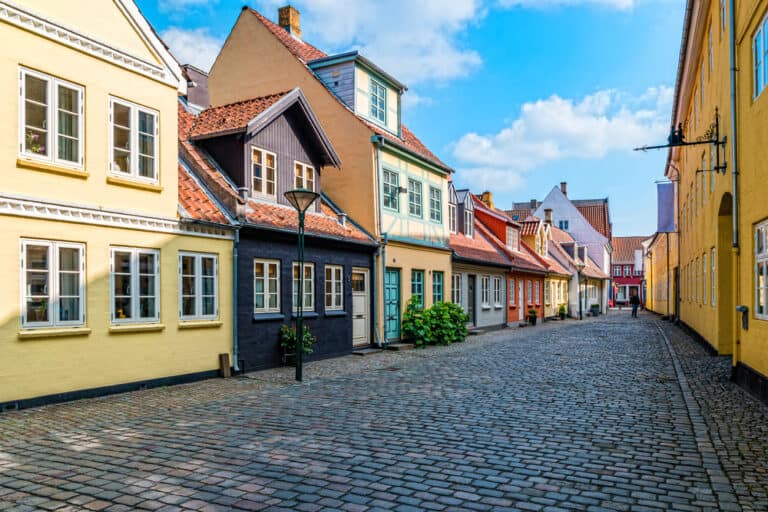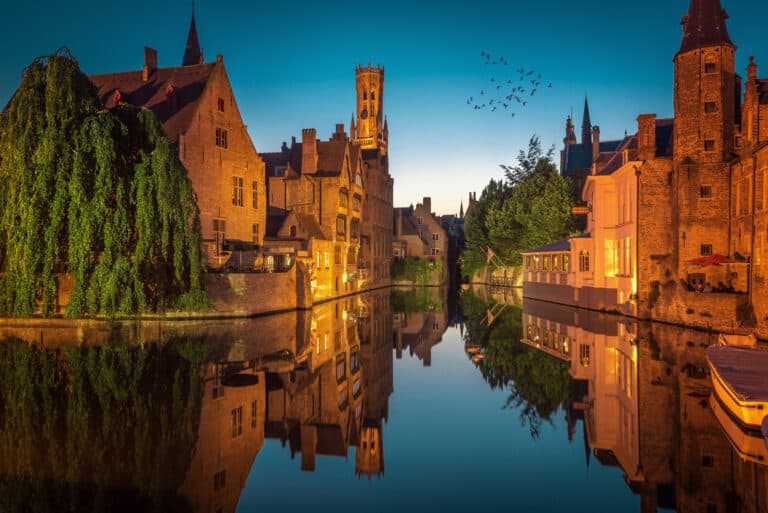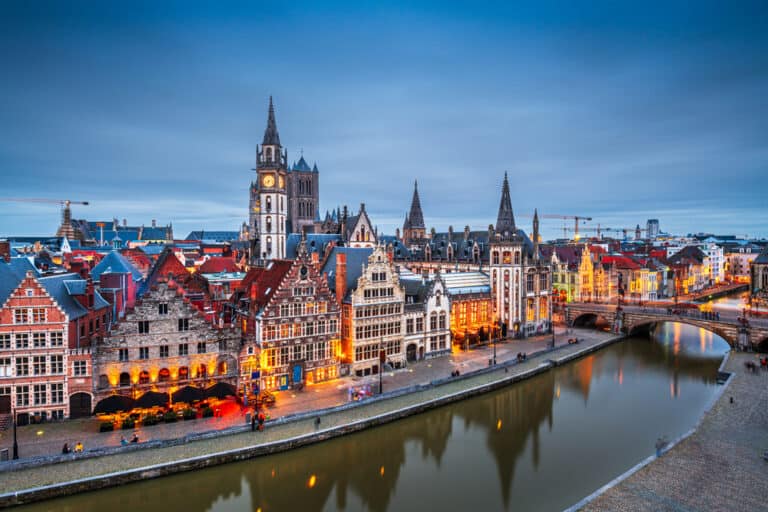Day trips from Tirana, Albania: Kruja
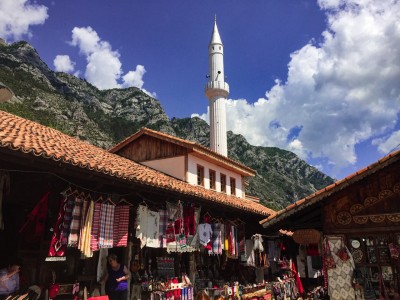
By Emma Marshall and Nick Warburton
This post contains affiliate links
Thanks to its political isolation for nearly half a century, Albania has, understandably, rarely figured as a destination of choice on the tourist trail.
That’s a shame because the country will undoubtedly captivate you. We certainly found this on a short break to its capital Tirana a few years back.
What’s more, there are a number of day trips from Tirana you can build in or short breaks elsewhere in this fascinating and unique country.
We spent a few days on the coast, seasiding in Vlore. We also visited the unmissable fortress town of Kruja, the historic home of Albania’s national hero “George Kastrioti” Skanderbeg.
Read on for more information on what to do in Kruja (sometimes spelt Kruje), one of the day trips from Tirana you can build in to your trip.
Where is Kruja and how do I get there from Tirana?
Located in north central Albania, Kruja is only 30 km north of the capital.
It’s even closer to Tirana International Airport, making it an ideal place to stay the night before your flight home. Taxis to the airport should only take about 30 minutes and cost you around 20-25 euros.
For those who choose not to stay overnight, Kruja is an easy day trip from Tirana and you can reach it by minibus.
The journey should cost you less than two euros with a journey time of between 45 minutes and an hour. We decided to go by taxi, however, which is preferable if you can afford it as it makes the journey slightly quicker.
If you do decide to travel by minibus, our guidebook advised us that some go only as far as the nearby town of Fushe-Kruja.
Although it’s possible to change minibuses here for the journey up to Kruja, if you have limited time, it’s advisable to take a minibus from Tirana that goes all the way.
What is there to do in a day trip to Kruja?
For us, part of the attraction of visiting Kruja was the memorable road trip and the spectacular scenery you are afforded on the way up.
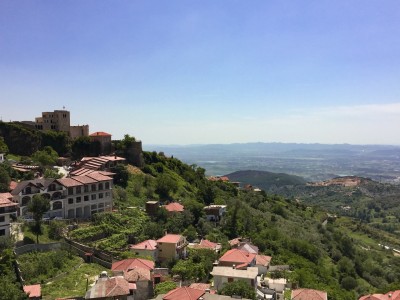
The car snakes up steep hills, zig zagging through dense forest one moment and then past steep crags the next. The view is quite breathtaking.
As you climb up to the fortress (usually referred to as Kruja Castle), you can get glimpses of the town’s distinctive white minarets and the outline of the imposing fortress complex.
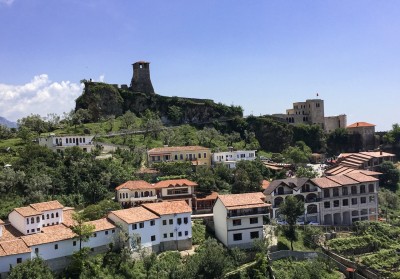
Once you actually reach Kruja, there is plenty to do in a day trip or short break.
The following summarises what we think you should do in Kruja. However, for more ideas, check out the Bradt guidebook on Albania.
Visit Kruja’s fortress
The castle grounds and views
The main draw in Kruja if you’re visiting on a day trip from Tirana is without doubt its fortress. This is set high on the hill with its ancient tower and well-preserved medieval walls.
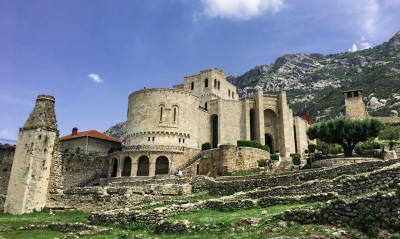
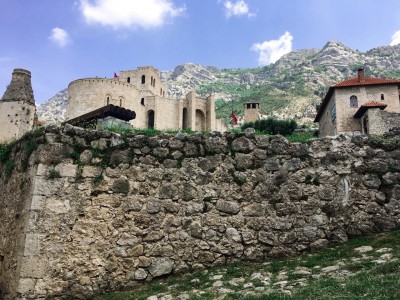
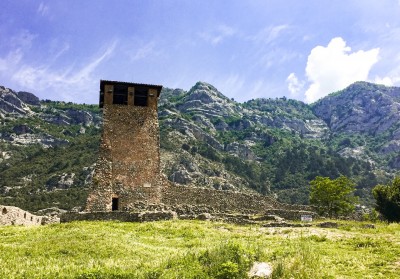
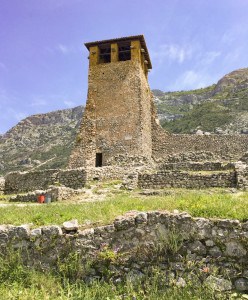
The oldest parts of the complex apparently date back to the 5th or 6th century. Other parts (e.g. the National Museum) are relatively modern. You should spend some time wandering around the extensive grounds while here.
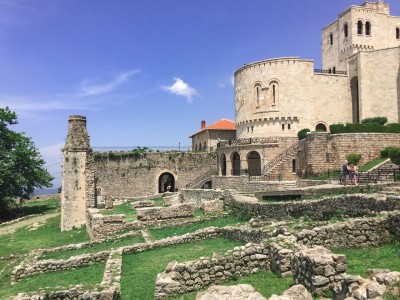
When you do this, you’ll no doubt wander out into some of the highest points. From here there are some amazing views.
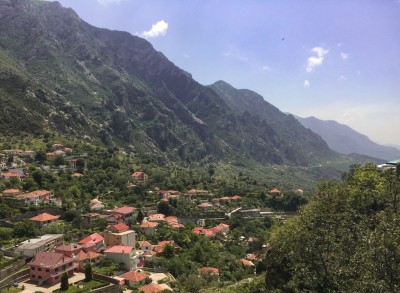
On a clear day, you can actually make out the coastline and the Adriatic twinkling in the distance. The eagle-eyed may also be able to spot the odd plane coming into land at Tirana’s airport far below on the plain.
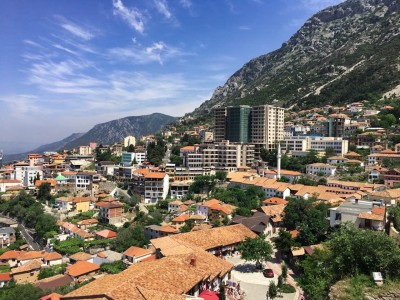
Part of the complex includes a Bektashi Dollma teqe (a Sufi temple) and a 15th century hammam (bathhouse).
For the Dollma Temple, you need to remove your shoes before entering. The hammam comprises a changing room, a middle room and two separate bathing areas and is worth exploring if you have time.
As you wander around the grounds, you will soon realise that local families still live in the castle grounds.
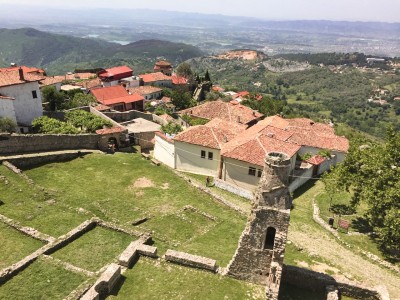
The residential area can be reached via a series of cobbled pathways that lead downhill from where the museums are located.
It’s interesting wandering these narrow lanes to get a glimpse of modern Albanian life beside the ancient history.
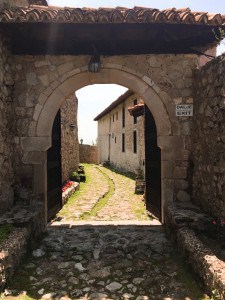
The museums
You’ll also find two museums within the fortress walls – the National Ethnographic Museum and the National Museum.
National Ethnographic Museum
Located opposite the entrance gate, the National Ethnographic Museum is housed in a beautiful three-storey building that dates back to the mid-18th century. We didn’t manage to visit but from what our guidebook said, it is one of the best museums of its kind in Albania.
The house once belonged to the prosperous Toptani family. Some of the 15 rooms have been carefully maintained to showcase the original furniture and internal decorations.
Highlights apparently include the magnificent painted ceiling in the reception room. You can also marvel at the museum’s impressive collection of traditional costumes and jewellery.
The museum is open every day from 9-6pm. According to the Into Albania website, general admission is 400 lek (about three euros).
There are reduced rates for children aged between 12-18 years and students and large tour groups (check out the site for more details). Children under 12 years can enter for free.
The National Museum
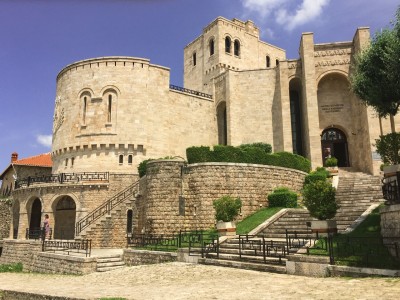
Designed to vaguely resemble a castle, the National Museum “George Kastrioti Skanderbeg” – also known as the Skanderbeg Museum or the Kruja Museum – is the main tourist draw inside the fortress walls.
Opened in 1982 during the dying days of Enver Hoxha’s rule in Albania, this national museum is a fascinating place to explore. The ground floor covers the Illyrian, Roman, Byzantine and medieval periods.
However, the focal point is Skanderbeg and his legacy. Skanderbeg is Albania’s national hero who successfully beat off three Ottoman attacks on the castle before his death from malaria in 1468.
It’s hardly surprising then that he is so revered in Albania. As my separate post on Tirana outlines, the main square in the capital is named after Skanderbeg and there is a statue of the man atop his horse in one section.
Most of this impressive museum is given up to the man whose achievements case a long shadow over Albania.
The upper floors house an impressive range of artefacts, paintings, scuptures and writings documenting Skanderbeg’s incredible life. The bell from inside the fortress’ tower was apparently used to announce Skanderbeg’s death and is now located in the museum.
Stepping outside on the roof, you are awarded with commanding views of the surrounding countryside. This includes the town, the mountains and the castle grounds.
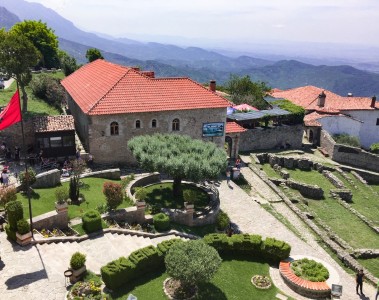
The museum’s opening hours vary. It is open every day from 9-1pm and 3-6pm. However, during May, June, July, August and September, the hours have been extended to cover 8-1pm and 4-7pm.
General admission is 500 lek (about five euros). There are reduced rates for children between 12-18 years, students and large groups. Children under 12 years can enter for free.
Wander around the town centre
Besides the castle grounds, there is the town centre which, although tiny, is worth pottering around.
The Ottoman bazaar
The highlight of the town centre is unquestionably the colourful bazaar. This dates back hundreds of years to the early 17th century.
Gillian Gloyer’s Bradt guidebook said the market, with its wood-built shops and cobbled street, was first restored in the mid-1960s. A second restoration a few years back has maintained its magical appeal.
Oozing with Ottoman charm and laid out on a winding cobbled street, the design is unique. If you look closely, the eaves of the individual stalls have deliberately been designed to be extra-long.
This means that when it rains or snows, the excess water falls into the gutter in the middle of the street. It then drains downhill, thereby eliminating the risk of flooding.
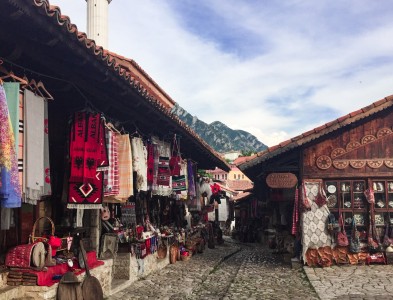
You should definitely spend some time browsing through the stalls and marvelling at the myriad of traditional, hand-made souvenirs.
If you want to buy something authentically Albanian before flying home, then there is probably nowhere better to pick something up than this market. It’s reputedly one of the oldest in Albania.
This spot is a tourist’s paradise when it comes to browsing for traditional souvenirs (there’s also some tat though, such as the obligatory ashtrays shaped like bunkers…).
However, displayed next to the Albanian t-shirts and mugs, you’ll find beautifully crafted rugs and embroidered tablecloths, traditional slippers and felt caps (qeleshe). There’s also wooden cutlery, silver jewellery, and elegant copper pots and plates, to name a few.
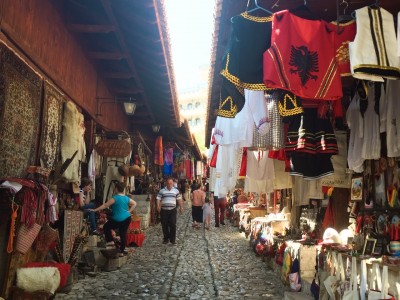
The Merat Beut mosque
The Merat Beut mosque’s chalk white minaret stands next to the market.
It was built in the 1530s and is considered a national cultural monument. As with all buildings of religious significance, the minaret only reopened after the collapse of communism.
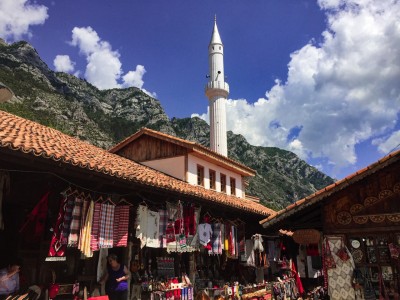
It is a beautiful building. As the light flickers different shades throughout the day and the call to prayers echoes across the valley, the mosque adds to the captivating atmosphere of the town.
The minaret, set alongside the market with its mountain range backdrop, offers a perfect opportunity to take photos.
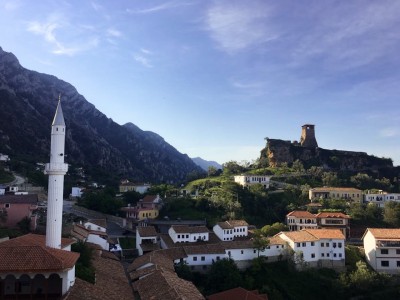
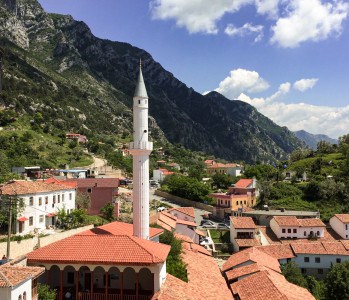
The Skanderbeg Monument
In the centre of town, there’s also the imposing Skanderbeg Monument. It’s impossible to miss this.
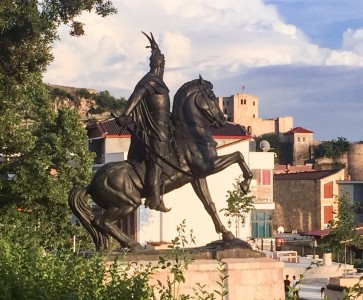
Erected during communist times in the late 1950s, the statue shows the country’s national hero charging into battle astride his horse. His sword is drawn ready for combat with the marauding Ottomans.
Sample some Albanian food
There are several really good eateries in Kruja.
For one of our meals, we tried out the Hotel Panorama’s restaurant in the central part of town.
Even though we’d been in Albania for a week and had been eating some wonderful and plentiful dishes, we were still astonished by the substantial portions and excellent quality of food here.
We had succulent grilled chicken steaks, fresh salads, amazing stuffed minty vine leaves, tasty local bread and cheeses. All washed down with large glasses of Albania beer and wine.
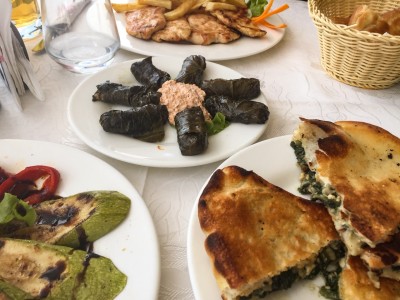
If you arrive at an opportune moment, you can sit overlooking the bazaar.
From your vantage spot, you can soak in the splendid view of the castle and surrounding mountains. We arrived late afternoon and sat in awe as the evening light faded and the silence was broken by the call to prayer.

There are more eateries around the town. But if you fancy going for a short walk, head through the bazaar and up towards the fortress.
Here there are a number of taverns offering snacks, and restaurants serving more substantial meals. You will also find some eateries inside the castle walls.
Opposite the entrance is KROI restaurant. This serves a mixture of Mediterranean, European and Albanian cuisine.
We didn’t eat here but the menu looked really appetising. Instead, we sat out with a glass of wine. The terrace at the restaurant’s rear offers fabulous views out over the valley and the plain below.
Where to stay in Kruja
Although a lot of visitors are on day trips from Tirana, we chose to stay overnight.
We stayed in a spacious room, complete with balcony, at the Hotel Panorama (for the price we paid, the size of the room was enormous). We’d definitely recommend this hotel.
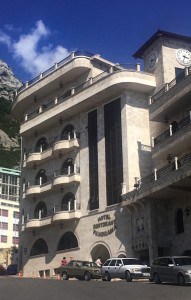
As locations go, you can’t go wrong. The back entrance leads you directly into the bazaar. Also, some of the rooms, like our own, offer breathtaking views of the castle and the imposing mountain peaks that sweep behind the town. They provide a stunning backdrop, particularly in the dying light.
You can also look down at sunset onto the Merat Beut mosque’s white minaret. For us, this was a perfect way to end a short trip in Kruja.
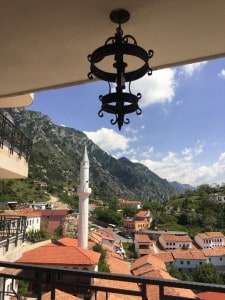
For further ideas for short breaks to Europe, check out my website.
And if you have any comments on this post, please do get in touch – we’d love to hear from you.
Jointly produced by Emma Marshall and Nick Warburton
Pin it!
